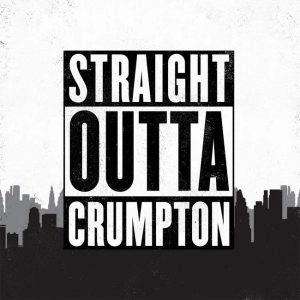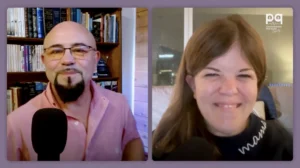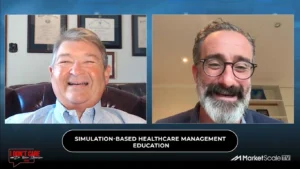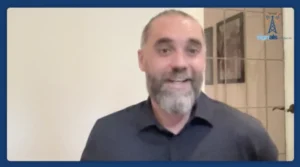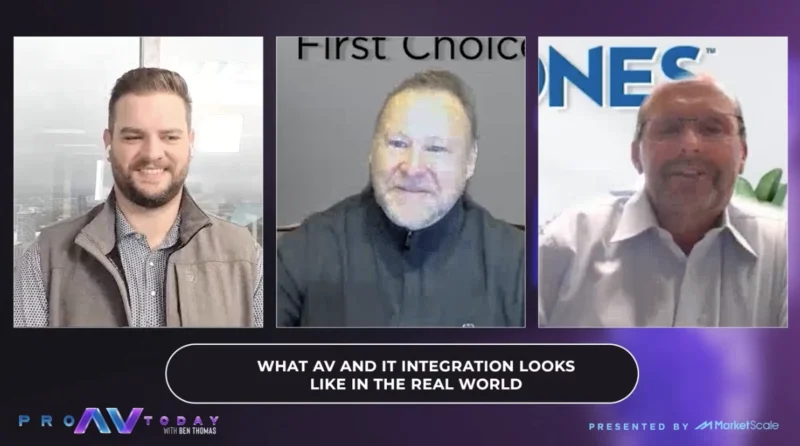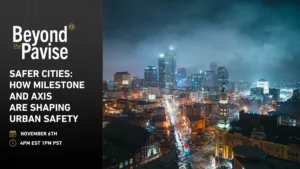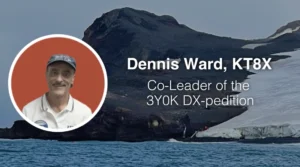Bridging the Gap Between Physical and Digital Experiences with Holograms
“The only source of knowledge is experience.” – Albert Einstein
Experiential AV exists in the space where the physical and digital worlds intersect. Creating these experiences is the primary mission for Proto Founder and CEO, David Nussbaum. Watch below as he joins host Ben Thomas to discuss the state of experiential AV and how Proto is aiming to bring the physical and digital worlds together.
*Transcript is auto-generated
BT: Hey, everybody, welcome back to pro av today. You know, as an av community, really our job is to empower connections and connectivity both in the physical and digital worlds. And, you know, those worlds intersect at a really unique spot. And typically we like to call that experiential av right. If you if you’ve been to a place like the illuminarium in Vegas and they’re kind of all over the globe at this point, or, you know, you talk about a real time hologram talking to you from across the globe where we’re able to really create experiences that otherwise we may not be able to through the technology. Right it’s such an interesting time that we live in because technology is allowing us to do a lot of different things. And one thing that really stands out to me and I always got a kick out of it is I was at infocomm and had a chance to interact with Howie Mandel and it was very unexpected, but it was really cool. He was actually projected in via hologram. And if you aren’t someone who is a fan of that technology, I encourage you to metaphorically change the channel because we’ve got the founder and CEO of the company who made that happen. We’ve got David Nussbaum, founder and CEO of Proto. David, Thanks so much for coming on the show.
DN: Thanks for having me on your show.
BT: Look, I love the product, but I’ve got to start with this question, and it seems almost goofy. But I would make a significant bet that you are the only person whose product in the AV community has been featured on TMZ. David, you’ve got to tell us what that was like.
DN: The same week I was featured on TMZ, I was also in Bloomberg and Wall Street Journal. I mean, it’s really wild. This is a very unique type of a technology company that spans from business to Entertainment and can be seen on TikTok as well as MSNBC’S. It’s kind of wild, but yeah, I think this is not the first time I was on TMZ. We we first time at proto I think was when we beamed Diddy to his son’s birthday party a couple of years ago, unable to sing Happy Birthday to his son in person, we beamed Sean Combs from Miami to Malibu so he could sing happy birthday via Hello. He loved it so much that he later invested significantly in the company. And is that the TMZ you’re referring to or maybe the OC and Howie, that you got coverage from the show.
BT: Now I feel bad that we’re just doing like a video chat here. I don’t know. I feel like we should, like, be full body holograms talking to each other, but I don’t know, maybe next time for sure.
DN: Yeah, next time. Next time. That’s we got to build that integration into the show for sure.
BT: And I’m sure we’ll talk a lot about doing just that. But David, it’s funny because, you know, when you look at the path that a lot of people take in av, it’s everything from, you know, musicians whose careers didn’t quite pan out to superfans like me. I got into the industry because of Michael Jackson music videos, which is a little weird but kind of cool. There are so many different paths that people take into the industry, but I think it’s really, really interesting where your roots are because I think it’s actually really helped inform not only broadcasting people over video, but really the way that you guys have developed technology over the years. David you started in terrestrial radio. Tell us a little bit more about how you got started and how that’s impacted really your thought process and your inspiration for where you’re at today at proto?
DN: Yeah, I love broadcasting. Always have. Ever since I was a kid, I thought I was going to be calling the play by play for the New York Mets when I was growing up. Spoiler alert didn’t. However, when I moved to Los Angeles in the late nineties, I did get a gig with some sports radio stations. They didn’t put me on the air right away. I was selling airtime. But to hear my voice on the air, I would style like a 60 second commercial. And then I would really just sell them the opening 10 like a 10 second open, a 10 second close, and then the 40 seconds in the middle. I’d do an interview with a Los Angeles Laker. I was working for the Lakers Radio Network at the time, so Kobe and Shaq and Luke Walton, and it was really great. So I quickly moved through sports and talk radio, found myself talking on some stations sometimes. Wasn’t very great at it found I found my life as a podcaster in around 2008, did almost 300 celebrity interviews from my living room when I was living in Hollywood. I just loved broadcasting so much. I actually ended up meeting my wife on episode nine of my podcast, and some of my best friends to this day are people who I interviewed. It was like our first meeting with my now wife and mother of my three children. It was our first date. Meeting her on my podcast. Now I’m still in broadcast. I broadcast people via hologram. It’s the evolution of communication, and it is a true connection. It’s not just chest up like you see me, here it is. It’s full body, it’s volumetric and it’s real time and it’s absolutely wonderful. But it is just the path I took from being, you know, this is what happens when you don’t hire me to be a broadcaster on your radio station. I have to come up with a whole new idea how to broadcast.
BT: Well, that’s our job as a community, right? To figure out the how. And then get to the why a little bit later. But it’s such an interesting market, really, that not only you guys live in, but, you know, companies like hollow plot and even people in the space that are designing, you know, interactive vr, Ar elements, things like that, because experiential AV is I don’t want to say it’s new by any stretch of the imagination, but we’ve hit a point really where it’s enabling technology at scale for us to have communal experiences. Right and with that kind of said, one of the things that I want to ask specifically is, you know, what are some of the things that you’re seeing demands from for from audiences, designers, even installers as we move into this experiential AV world that you guys are such a big part of.
DN: The company is really focused on enterprise, commercial and retail for the time being. So we’re putting our devices in. We’re at every trade show and every convention, but. A little bit different. We’re being hired to be at these places as a kind of a whiz bang. Jaw dropping or inspiring kind of kiosk of hollow station really draws crowds in. So we’re definitely taking advantage of the fact that when you see one of our projections inside of one of our displays, it really does draw a crowd and it’s a conversation starter. It’s also a really great, interactive, engaging communication device. But because of stuff like that, our customers are finding us at these conventions and we’re going into banks, into museums, into art galleries and airport terminals. But really, we’re being used mostly right now in innovation centers and in conference rooms.
BT: You guys get to live in so many different spaces to everything from beaming DJs and musical acts across the globe and into concerts and into conferences and things like that. But also being in that museum airport kind of wayfinding world. It’s such a fun thing to see not only how we’ve expanded as a community, but some of the ways that the users and the installers have found ways to utilize the technology, maybe in unexpected ways. What are some of those ways that have jumped out to you?
DN: Christie’s recently reached out to us. We we were at Art Basel and we were projecting NFTs. Didn’t know we were an NFT display. Turns out we’re the best NFT display because for like if you’re going to spend hundreds of thousands of dollars or into the millions of dollars on these amazing one of a kind pieces digital artwork, why display it on a phone or on a screen? All of a sudden, we now have this volumetric museum quality lightbox that allows this 4K realistic projection to appear. So here we are. We’re at we’re at Art Basel and we’re beaming all these NFTs in and people are going bananas over it. We get a call from Christie’s or maybe we called Chris. don’t exactly know how the media. Long story short, because I know this is I don’t want to take up the entire podcast.
BT: It’s your show now. You’re a broadcaster. So we’re one and the same.
DN: So can we talk up a record maybe. So the point of this particular story is Christie’s is using it not for NFTS, but to actually scan true pieces of artwork. And with and we’re talking about recently a Degas sculpture, for example, it was valued around $30 million. It’s one of a kind work of art. It’s a historical piece. And instead of sending it from auction house to auction house around the world Hong Kong, new York, San Francisco, Los Angeles, so people can see it with their own eyes and then place their bids on it all they did. Super zero carbon footprint and also no wear and tear. They just from their own showroom in New York beamed them to all locations simultaneously. More people saw it, so more people bid on it. And it went for a record breaking 46 and one half at auction. And so now we see Christie’s we see auction houses, even like Logan Paul, who has this really cool new collectibles company where they fractionalized. So you can own a piece of a Pokemon card or something even. We’re working with all kinds of people from, from historically known like business people to even Logan Paul, who is becoming a he’s a he’s a he’s a wrestler. He’s a boxer. He’s a businessman. He’s a YouTuber. So we’re getting calls from everybody and we’re doing all kinds of really unique things, not just with people, but with, with objects.
BT: Well, you’re about to take me on a tangent. I don’t know that you want me to go down. You talk about Logan Paul and you talk about, you know, WWE and things like that and him being able to really transcend each of those different worlds. Right but one of the challenges of technology like this, whether it’s beaming Logan Paul across the globe at one time or whether it’s getting Steve Aoki to dj, your party has been historically scale. And one of the things that really jumped out about proto specifically is guys almost were designed to scale, whether it’s simultaneous live streaming, whether it’s even taking a show on tour or repeating an event or things like that. Talk to me a little bit about how you guys not only have designed for scale, but how you’ve seen the market demand that scale.
DN: Yeah, you know, so after podcasting and broadcasting and before proto, there was a stretch of years where I was producing digital content in Beverly Hills. We found ourselves the owners of a patent that was. Used, most famously to put Tupac on stage at Coachella is the patent for Pepper’s ghost. Here in North America. Pepper’s goes with Pepper’s ghost. It is. Maybe you’ve seen it at Universal Studios or at Disneyland or maybe a David Copperfield magic trick. It’s a giant stage. And also with Tupac. And when we digitally resurrect late legends to posthumously perform, I mean, it’s a giant sheet of foil or plastic. It’s completely see through. It sits at a 45 degree angle. It’s sort of like a teleprompter. There’s projectors on the ceiling and LEDs on the floor. And there’s the truss structures over here and there’s curtains over there. And there’s like I mean, it took so not scalable, very expensive, how to turn off the lights off in order to project an image because you’re using regular projectors. So luckily I did the opposite of that. I learned what not to do about holograms or what people generally call holograms. It’s not really a hologram. It’s a digital likeness. It’s a real presence of a person. Not a traditional hologram, but. People call it hologram, so I call it hologram. But so what I do, what I did was, OK, people say, I don’t want it to cost as much money. I want to be able to put it in the corner of a conference room or my retail store. I want to be able to turn the lights on. I want it to be able to move around. You know, I don’t I’m I barely know how to work my DVR. I’m going to work a hologram machine. So I made it easy. I said, if I can do it a broadcaster, then, then grandpa and Tammy can do it. And so that’s where proto was born. It’s single passenger. Totally user friendly, completely self contained, hollow quotation machine beam, anybody from anywhere to anywhere in real time. Turn all the lights on and hook it up to the internet.
BT: Look, you make it sound a lot more simple than maybe it is. But what’s exciting. And I want to take on the peppers goats thing for a second. Peppers ghost was really going back to the 50s, 60s. You look at haunted mansion, it’s what they use in several of their scenes. And, you know, it’s easy to see innovation as like this linear path. It’s like, OK, we’re going to go from Pepper’s ghost to holographic displays to, you know, there are some partners out there that are doing like the fan holograms and things like that. But the reality is, look, you even talk about tupac, right? That that being an installed product was the same technology from 40, 50 years prior. But how does that how does that technology inform the new technology? Right obviously, you take principles from projection and peppers goes in, place them into the proto box. Talk about how that past technology is informed. Your current technology.
DN: Sure Pepper’s ghost was actually invented in the 1800s. So like the 1860s, not just the 1960. I mean, this is an old theater trick. So I am know, I’m AI like to try lots of different things until something works properly. The proto box is like the 10th version of what I thought the company was going to be. I, I had some ideas, what I really wanted it to look like and I tried and I couldn’t make it happen. And I spent a lot of time and money trying to figure things out. And, you know, it’s good, though. It’s good to fail a lot because then you finally get to that thing that is successful. And the proto epic or the proto box is just that thing. You just have to keep you have to just keep knocking on doors. If you’re a salesperson, you have to just keep tinkering until you find I’m not an engineer. I didn’t go to school for engineering. I just know that when I saw what happened, when I finally figured out how to project the image. Onto a display when I saw it look like the person was inside of the box. Wonderful and. But that would have all gone away. None of this would be happening. You and I would not be talking if it wasn’t for all of the people who make it possible. I had a great idea and I managed to kind of. You know, just I pushed it along as far as I could, but I really needed everybody else. I’ve got such an amazing team of people. Honestly, none of this could be done without them.
BT: Well, look, I appreciate especially calling out the engineers. Those are the I’ll call them the secret sauce of AV and technology. They need. They need much more credit than they normally get. But, you know, it’s interesting you talk about different versions of technology and whether that’s IP based technology or, you know, CRT technology. There’s a lot of different iterations across really verticals. And one of the things that really jumps out is the demand for interoperability in our technology these days, whether it’s being able to integrate the audio feed from a proto box into a PA or being able to film a hologram for a live stream, or heck being able to move it and physically incorporate it into the staging and design. You know, talk to me a little bit about how interoperability specifically plays into what you guys are doing.
DN: Yeah, I’ve got a few different. So we talked about Diddy, but and you started the conversation talking about how. So let’s go back to Howie Mandel, who is he has now become an investor. But when we met, we were just we just became friends. He says, hey, move into my production studio. I’m really into what you’re doing. He loves technology. He totally gets it. Wonderful guy. We beamed him and his daughter, Jackie. They have a podcast together. I don’t know if it competes with yours, but it’s a very good podcast. It doesn’t compete. But he I think he gets a couple more viewers than I’m not as good as your podcast. But so they flatter me. They do a podcast and they actually have one of my epic machines in the studio so they can beam guests in. So instead of doing it like this, they actually can beam in live people. So if you after you’re done watching the don’t stop here, but after you’re done watching this whole episode, you should check out one of his more recent episodes. You could see how it actually it works in a podcast, but the flip way we beamed him and his daughter and also Andy kindler, who’s a very funny guy. We beamed them to just for laughs Comedy Festival in Montreal from Los Angeles. We put the prototype epic on stage in front of thousands of people. Andy kindler beamed in, and he was picking people out. He he’s sort of like a roast comic. He he’s, you know, he does this thing every year. Just for laughs, by the way, is the Coachella of comedy. I mean, it is the top Comedy Festival in the world. So they put the device on stage, they hooked it up to the AV system. So everybody was able to hear him. He was able to hear the audience. Audience was miked. He was miked. And it was a true to a multi way conversation. It looked like he was really there. Same thing goes with music and other. Like, we’ve done this with New York Fashion Week with beamed in fashion models. We did this with recently at in Napa Valley at this concert called live from the vineyard. We beamed in Walker Hayes, who sings that song fancy, like, I’m not going to sing it for you. But I think we’ve all seen the Applebee’s commercial. So we beamed him onto the stage. More people. He was the only hologram on stage before him and after him were actual live people who weren’t holograms. They were performing on stage. More people held their phones up and recorded or livestreamed Walker Hayes’s hologram and put it on social media than of the actual real people. So it really as far as being able to. Get your money’s worth out of a projection. Certainly we’ve done the case pretty well across everything from hologram advertising to comedy and music and fashion and beauty.
BT: Well, it’s cool to see the ways that people have already used the technology, but, you know, thinking ahead five, ten, 20 years, you know, what’s the next step for the tech? Is it bigger screens? Is it transparent backgrounds? What what is on the docket for you guys? Move forward. Sure bigger screens, transparent backgrounds.
DN: Those are all part of we’ve got a roadmap of ideas that are. 20 years long. I’d say in the next five years, we’re replacing the computers in your home. M the m device is a Wonka vision sized version of the epic. So it’s everything the big one is but shrunk down into a little mic. TV you’re going to see a little David Nussbaum kind of beaming into your homes. It’s your computer. But after you swipe through the computer elements, it then becomes a volumetric, transparent display that allows you to see things in three dimensions in full and full volume. It is a hologram. Alexa meets hologram, Zoom meets hologram master class. And it’s got all of the same elements that you would have on your tablet or on your desktop computer at home.
BT: Look, David, a man after my own heart, making Willy Wonka references like that. You know, that movie scared me a little bit as a kid, but it really informed a lot of my creativity. So I don’t know if you knew that coming in, but I really do love that movie. But David, you know, I appreciate you coming on today. Obviously, you know, the technology is always constantly changing, but it’s really important to have these conversations and talk about some of the things and some of the applications that people might not see on the surface. And I appreciate you giving the perspective of proto. Again, we’ve been talking with David Nussbaum, founder and CEO of proto. David, Thanks so much for coming on.
DN: Have me back. This was fun.
BT: I will. The only thing that I’ll ask, I’ll have you back on. If you have Steve Aoki. find a way to DJ a show here. Maybe Shaq. I don’t know. Shaq’s DJing these days, so we’ll see.
DN: We’ll see. I don’t know if I could squeeze Shaq into one of our devices. I might. I will have to go bigger for shaq, though, for sure.
BT: Well, thank you again, David, and thank you guys so much for watching. Be sure to tune in next time.


